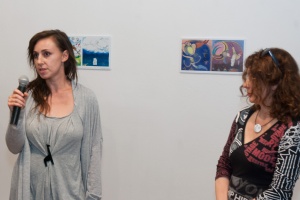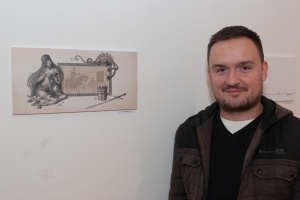On Monday night, an exhibition of illustrations- Voli Me / Ne Voli Me opened on the top floor of the national gallery. Featuring a mixture of Croatian and BiH illustrators, the exhibition is being held as part of the Pazi! Knjiga festival, whose events are happening mainly in Zagreb.
The artists involved were invited to interpret the theme (Loves Me / Loves Me Not in English) as broadly as possible and the show is an engaging collage of whimsy, symbolism and introspection. In addition to the entries of the illustrators, two names from other fields of the arts were invited to contribute- the prolific Milomir Kovačević, and a video piece from Ismar Mujezinović.
The visual styles adopted were in places surprising and innovative. Emir Durmišević’s steely, spare, detailed image drew heavily on mediavelism and and legend, cleverly incorporating a picture-within-a-picture to open out the dilemma facing his main female character. Durmišević’s image also leans heavily on contemporary gaming imagery, which his practice as an illustrator focuses on.
Others, such as Edita Gazibara and Maja Zećo, enjoy metaphorical play; Edita with open and closed furniture, Maja with a game of multiple, inconclusive noughts and crosses in red on a white background. Elvis Dolić exploits the cloak of a gigantic organic form in his piece, whilst Ždenko Bašić, with his two male figures sat with their backs to one another, creates a complicated, layered piece that invites repeated looking.
One of the issues that was raised during the opening speeches was the difference in colouration; the Bosnian images were, largely, monochrome, with the Croatian illustrators seemingly much more ready to experiment with colour. I am not sure that we arrived at the reasons for this difference, but in any case Tomislav Tomić bucked the trend. Tomić showed a fascinating black and white Rackhamesque interplay of plants and insects, rhythmically interlinked and visually mysterious. This uncertain and slightly sinister fantasy world that belies his background in children’s illustration.

Aleksandra Knezević (left), organiser of the show in Sarajevo, at the opening.with Ane Đokić, organiser of the project overall
Also noteworthy was the minimalist watercolour drops by Sanja Pribić; one drop of pure aquamarine, becoming two- simple but extremely effective and visually distinctive from the busy images that surround it. And Davor Pavelić has a delightful small diptych here, featuring a trademark cobalt blue and red contrast, and carefully mixing the visual metaphors of construction and theatre; the overall appearance is of a late 1920s theatre poster, updated for our times.
Ismar Mujezinović’s video piece breaks up the array of illustrations and adds a visceral ballast to the whole show. The film shows a barefoot man walking ginerly on a wooden floor with nails sticking out of it; some flattened to the surface, others spiking out into his space without pity. The implicit interplay of relief and pain is an unexpectedly frank intervention in the theme.
Overall this is a show fizzing with visual invention and energy and with more than the occasional surprise. It is only on until next Monday, so catch it while you can.
Jon Blackwood
Voli Me / Ne Voli Me, a part of the Pazi! Knjiga festival programme for 2013, is open now on the top floor of the National Gallery of Bosnia-Hercegovina, and will run until the 28th October. Admission free.



